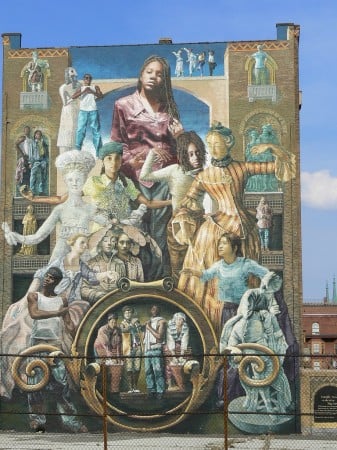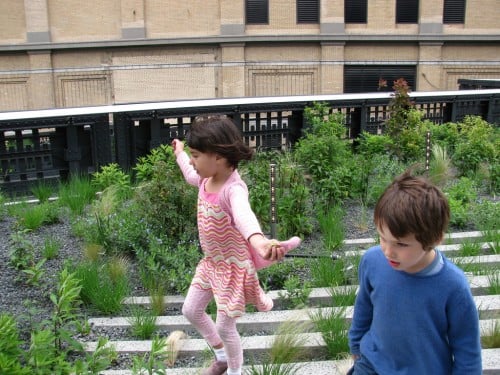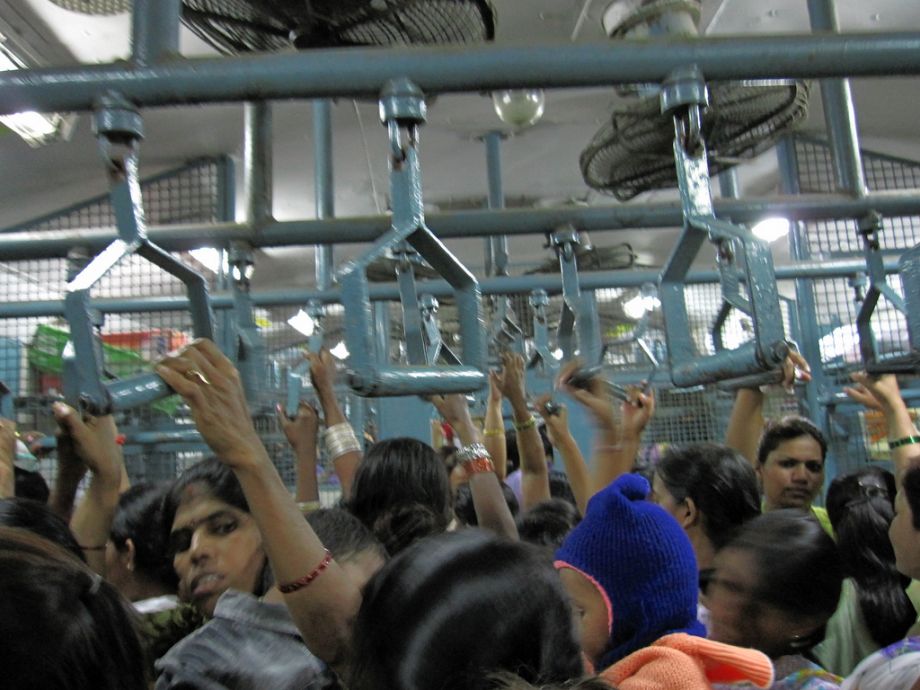From April 7-10, Next American City hosted a liveblog of Cities and Women’s Health: Global Perspectives, the 18th Congress of the International Council on Women’s Health Issues, at the University of Pennsylvania. Here, a collection of highlights and takeaways from the conference by NAC’s team of bloggers.
The conference, which convened 400 professionals in the fields of urban design, health sciences, health policy, law, social policy, education and sociology, among others, identified and analyzed best practices and new strategies to enhance women’s health in cities. Many of the participants, who came from 32 countries, noted that “women’s health” translates to family health, since women are the primary caretakers of children in most of the world. Finding solutions to systemic problems in health care and providing them to women worldwide will lead to their imparting healthy lifestyles to future generations, male and female alike. The spectrum of information covered at the conference was extraordinary: participants discussed everything from reducing infant mortality to fighting sex trafficking to improving access to health clinics in urban areas. While many of the images and stories conveyed were harrowing, the optimism at the gathering was palpable, as was the drive and determination of the researchers and professionals determined to make the world’s cities healthier places to live, and the women within them empowered to choose better health for themselves.
Here’s a sample of each bloggers’ work. Click here to the complete live blog to read accounts from all four days.
Transforming the Urban Environment | Apr 10th at 10:21am
Julia Ramey Serazio
This morning, a panel of planners and local community leaders spoke together during a plenary session called “Transforming Urban Environments: Inegrative Models to Build Healthier Urban Communities.” Each provided examples of ways in which struggling urban areas were improved through specific projects ranging from the structural to the creative to the social.
Diane Cornman-Levy, Executive Director of the Federation of Neighborhood Centers, which provides human and social services to 75,000 families each year, introduced her talk by laying out some dire statistics about the City of Philadelphia: 12 percent of people are diabetic, 36 percent have high blood pressure, 27 percent of children have asthma and it’s very difficult to get access to fresh foods (Philadelphia is the second-hungriest urban area after the Bronx). Cornman-Levy said the best way to tackle these and other problems is to organize women, since women are the heads of families, and encourage them to get creative. And so was born an urban farm in one of the city’s poorest neighborhoods — ad a youth-led one, at that. It has engaged teens and given them income, and has served the community at large: Last year the farm produced 7,000 pounds of food and 25 percent went to food cupboards.
Grace Dyrness, of the Institute for Transnational Research and Development at the Institute for Urban Initiatives, is a planner, and while she admitted to wondering initially why she was invited to be at this conference, she said, “I have definitely caught on to how the urban environment is integrated with health.” Dyrness, who’s performed research in Tanzania, Kenya, Oakland and L.A. and teaches about the social context of planning (“we need advocate planners,” she said), identified four ways that she’s observed that women cope with life at the margins of urban society. They are:
— Cities are a space for opportunity for women, as they provide a way in which women can earn income, which in turn gives them power within their own families.
— Women create strong social networks for mutual support. When one gets sick another will fill in so the first, say, doesn’t lose her customers.
— Women care for other people. Dyrness met a women in Kibera who took care of 500 children; this is how they find purpose and meaning.
— Religion. When women arrive in the city, they often form networks through their religious practices. It’s important, Dyrness said, to embrace religious communities in larger planning efforts and that interreligious coalitions engage with community life.

Jane Golden, Executive Director of the Philadelphia Mural Arts Project, introduced her prolific organization, which has created 3,225 indoor and outdoor murals since 1984. It serves over 2,000 young people and engages around 350 artists each year. “The program has been driven by the spirit of women,” Golden said. When the program started, the only imagery in most poor neighborhoods was contained within alcohol and tobacco billboards. Murals, Golden said, make art accessible to everyone, they help organize people in the community and beautify “expendable space.” Golden ended with a quote: “People need to create their own history, to leave traces of themselves and the meanings they generate in their lives.” “People are looking for meaning beyond beauty,” she added. “What we see is the resilience of the human spirit. The victory is always sweeter when you understand the obstacles that people had to overcome.”
Finally, David Gouveneur, a Lecturer in Landscape Architecture and City Planning at the University of Pennsylvania and Universidad Metropolitana in Caracas, spoke about a transformative project in Medellin, Colombia. He said that when looking at massive urban slums in fringe areas, what is needed is an “acupuncture” approach — one that involved the least invasiveness and effort but with the most potential for response. He told the story of a teacher in Medellin who wanted to connect the fringe barrios and the “formal” city. He didn’t want to take a “Haussman approach” and bulldoze in a major avenue; rather, he built an aerial gondola. Then, he went on to find and map the best social facilities, and he placed them along the gondola route, all with the underlying belief that physical mobility translates into social mobility.
Photo by TIm Pearce, Los Gatos, via flickr.
What Stays With You Latest and Deepest? | Apr 9th at 3:38pm
by Rachel Somerstein
There are sentences that remain with you forever, images that become part of your self for the rest of your life. I feel that way about the image of the dead puppy floating in the ocean in Joseph O’Neill’s Netherland (which had nothing to do with the plot), even though I didn’t much care for the novel. Same with Dexter Filkins’s description of a Jihadist’s head blowing off, which greets readers in the opening pages of his book, The Forever War. (His book I care for greatly.) Lexi Rudnitsky, before she died in 2005, wrote a lovely poem about this very topic called “Deepest Remains.” (The headline, which she quotes in her poem, comes from Walt Whitman.)
Conferences, while terrific for making new contacts and learning new things, don’t generally offer that type of bone-cracking image.
This afternoon proved the exception. The source: Dr. Susan Martin, Director of Georgetown’s Institute for the Study of International Migration in the School of Foreign Service. When in 1984 Martin visited refugee camps in Thailand, she said, the camps were filled with children and older people, but no adolescents. (The refugees had come from Cambodia.) It was clear, she said, that the young men had been inducted into combat. But where were the women?
“The pretty ones are in Bangkok,” someone finally told her. Translation: the brothels.
And what about the plain young women?
They had been forced – trafficked – into supporting the young resistance fighters. That meant sexual and domestic services – horrific enough. They were also responsible, said Dr. Martin’s source, for clearing the mines.
Clearing the mines? asked Martin. How would they do that?
By walking in the minefields in front of the men – so they get blown up first.
Evidently, Martin couldn’t get this out of her head either. So she did the only thing she could do: she wrote a book about it: Refugee Women
Recap: Urban Migration: Global Challenges and Strategies for the Design of Healthy Communities | Apr 9th at 12:31pm
by Katie Drummond
The catalysts that force citizens to flee their own country are diverse: natural disaster, abject poverty, political uprising. The consequences, however, are often the same, and inevitably pose severe risks for the physical and mental health of women subsisting as displaced persons.
Today’s three-person panel on forced urban migration started by clearing up misconceptions about who counts as a displaced person or a refugee, and where these millions of men, women and children end up. Susan Purdin, Deputy Health Director of the International Rescue Committee, notes that forced migrants can be circulating within their own countries (an estimated 700 million) or across international borders (another 13 million). The latter constitute legally defined “refugees,” but both groups face challenges of access to housing, health care and employment, among other needs.
And refugees aren’t necessarily confined to rural camps. Worldwide, an estimated half actually eke out a life for themselves within large urban centers. Of Kenya’s 400,000 displaced persons, 100,000 live in the urban mecca of Nairobi, according to Purdin. Urban refugees often face more pressing dilemmas: Whereas refugee camps are usually established to proffer vital services like food and sanitation, refugees in large cities are largely left to their own devices.
That forced independence means they’re likely to end up working without a permit, living in illegal slums or otherwise violating the terms of their residency in the housing country. Emily Butera, a program officer with the Women’s Refugee Commission, warns that forced refugee detention is a growing risk, as more and more refugees flee to urban areas. In the United States, detained refugees fill 33,400 beds in space rented from state and federal prisons. There, refugees are akin to criminals: Wearing orange jumpsuits, they’re allotted an hour of outdoor time per day, and have limited access to lawyers or family members.
Not to mention accessing reproductive care, in the case of refugee women. Birthing takes place in prison hospital facilities, with women shackled during labor and delivery. Once they give birth, their babies will grow up inside the detention centers, because the U.S is one of the only countries worldwide that continues to detain refugee children.
The United States detention system is rife with problems, from accusations of cultural insensitivity to dangerous safety hazards: 107 reported deaths have occurred among detainees since 2003. But Butera is emphatic that positive changes need to start here. “If the United States can reform their policies, then we know the rest of the world is watching,” she said.
And even women and children who avoid detention might face another kind of imprisonment. They’re the vast majority of the 8 million people trafficked across international borders each year. Dr. Susan Martin, Director of Georgetown’s Institute for the Study of International Migration in the School of Foreign Service, remarks that women and children living in refugee camps are incredibly vulnerable to trafficking.
“With no rule of law, with no way to make a livelihood,” she said. “Clearly, when people are so dependent on others for aid, when that aid drops off, they’re at a huge risk.”
There’s no easy solution for such a complex problem. But Purdin has one fundamental prescription.
“We need to get girls in school, and we need to keep them there,” she exhorted.
With sexual education, greater employment prospects, and a sense of stable community, Purdin is confident that girls might better manage the potential risks wrought by natural disaster, social uprising or political conflict.
Tainted Love: Urban Violence and Women | Apr 9th at 11:58am
by Mara D’Angelo
Living in an economically disadvantaged urban environment can increase a woman’s chances of experiencing physical abuse, enduring sexual violence, and contracting HIV. And research conducted by Anne Teitelman in low-income Philadelphia neighborhoods suggests that the reasons for this have a lot to do with how poor women’s environments influence their relationships with men.
Teitelman, of the University of Pennsylvania School of Nursing, found that stressors in poor women’s communities can lead to unhealthy choices and a loss of power in relationships. For instance, in the neighborhoods she studied, where homicide rates are five times the national average and women are regularly heckled and harassed on the street, they often seek out partners with controlling, “protective” personalities as a way of gaining a sense of safety. But commonly, as relationships with these men progress, their controlling behavior turns from protective to abusive, and women are put at risk for domestic violence and sexual assault.
Likewise, female populations regularly outnumber male populations by noticeable margins in poor urban neighborhoods, an imbalance that results in an erosion of women’s negotiating power in their sexual lives: When a man can find a more permissive sexual partner elsewhere, it is more difficult for a woman to insist on condom use or resist unwanted sexual encounters, increasing her chances of unwanted pregnancy and STDs.
These experiences, Teitelman says, contribute to a female understanding of relationships that threatens their well-being: that male/female partnerships are inherently abusive, that men naturally take multiple sexual partners, even in “committed”, loving relationships, and that condom use is a choice left to men, rather than mutually negotiated.
And Teitelman draws a straight line from inequitable gender norms to female HIV contraction. When women are regularly coerced or forced into having unprotected sex, and when their boyfriends are likely to have multiple sexual partners, keeping women safe becomes difficult.
Her solution? Creating integrated systems for teaching low-income women about domestic violence and sexual safety, and using mentoring programs to build new, more healthy social norms in poor urban communities.
Olmsted with a Twist | Apr 8th at 3:10pm
by Margaret Eby
Frederick Law Olmsted, the founder of modern landscape architecture and the designer of New York City’s Central Park, thought of green spaces as a respite from the stresses of the city. His vision was for urban oases: places to picnic and stroll, take in hilly landscapes, and relax. Simply put, Olmsted’s parks were for sitting, not sweating. But the planners and academics in today’s session on Redesigning the City for Active Living want to take Olmsted’s template of green networks and adapt them for a fitter lifestyle, combating America’s rising obesity problem with an arsenal of planning innovations.

Children play on the High Line in New York City.
Dr. Angela Smith, an expert in sports medicine who works at the Children’s Hospital of Philadelphia, worked with a group of planning students at Harvard to design a series of “fitness parks” in West Philadelphia. The parks would work with what the neighborhood’s already got—vacant lots and triangular green spaces—to create places for the community to interact and rediscover the fun in physical activity. Obesity is a problem that’s hard to combat in these areas, Dr. Smith explained, because the options for exercise are either unavailable or unappealing. The students had an array of solutions, from hexagonal modules that the community could use for planting trees to old shipping containers converted into miniature playgrounds to “pocket gyms” with climbing walls erected in the nooks and crannies of the city. “We have to weave physical activity back into the normal social fabric, because it’s been engineered out of daily life.” Smith said.
ICOWHI co-chair Eugenie Birch’s presentation focused on similar strategies—making biking and walking easier and safer for New York City residents. The initiatives she outlined were part of the recently compiled Active Design Guidelines, a series of recommendations for designers that centered on encouraging exercise through architecture and planning. Birch looked at the recent success of the High Line in Chelsea, a green space built on a strip of rusting train track, as well as the city’s push towards bicycle use. Though these initiatives were originally part of Mayor Michael Bloomberg’s efforts towards environmental sustainability, they also had the potential to improve the overall health of city residents. “In other words,” Birch said, “anything to get people off their bottoms and onto their feet.” In other words, it’s time to take parks—and other green spaces—from the 19th to the 21st century.
Photo by edenpictures via flickr.
Another Kind of Reproductive Choice | Apr 10th at 12:50pm
by Karin Dryhurst
Opponents of health care reform griped that the plan would take away choice in health care. And supporters of reform argued that people already had little choice in a system that shut out those who could not pay.
The shuttering of St. Vincent’s Hospital in New York demonstrates that the profit-driven system doesn’t just limit choice through costs; it limits choice for any childbearing woman.
The New York Times featured the hospital as the last haven in New York—after the recent closure of the Bellevue Birth Center—for mothers uninterested in giving birth on drugs or through C-sections:
In a city where you can live however you want, as long as it’s safe — and sometimes even if it’s not — it seems absurd that there are so few places where women can give birth however they want, as long as it’s safe.
The article points out this is not just the concern of “hippy-dippy” moms. The WHO “has reported that once the C-section rates goes above 15 percent, preventable deaths and complications will occur, with no benefit to mother or child.”
And New York has a C-section rate of 36 percent.
This conference has made clear that stress on women can have serious consequences for their children, leading to low birth-weight and health risks, and on the well-being of women. And a 1 in 3 chance of C-section seems pretty stressful.
With the loss of St. Vincent’s, New York must work to support women who want to choose how to have their babies.
















